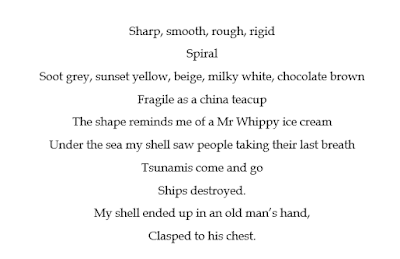Preparation: if you can provide some cheap rings
for the children to handle, that’s great. But they could quickly fashion their
own out of pipe cleaners or silver foil or ribbon, or you could use Haribo
‘Friendship Ring’ sweets.
Make the warm-up prompt something to
do with magic.
Discussion: what would you do if you
were invisible? Ask the children to make a list of advantages and disadvantages
to being invisible. What would an evil person do with such a power? What would
a trickster do? Could you use the power to help others?
Read them this story:
You’re in a strange city, wandering
around the shops, looking for a present for your mum. You go down an alleyway,
off the busy main street, where it’s quiet and the buildings look older and
shabbier. A shop sign catches your eye: Unique
Jewellery. So you peer into the grimy windows and you can just make out a
tray of very cool rings with a sign saying “The best gift you’ll EVER give”.
You push open the door and enter the
shop. Inside it’s dim and cluttered, packed with amazing objects. In the corner
towers a stuffed grizzly bear, balancing a spotted teapot on its paw. A live
robin hops from perch to perch, eyeing you cheekily. There’s a spiked German
helmet from World War 1 dangling from the ceiling above your head, and a row of
fairy lights shaped like cats’ eyes are twined round the shop counter. The
floor seems to be made up of pound coins set in plastic. Somewhere far off, a
music box tinkles faintly. You try not to sneeze at all the dust.
Then the shopkeeper emerges from
behind a red velvet curtain. He’s small with a face like a monkey and bright,
clever eyes. He asks you want you want and you say you’d like to take a closer
look at the rings.
Without another word he steps
forward, reaches into the window, brings out the tray and places it before you.
Your eyes boggle. They’re all amazing. Which to choose?
The more you stare, the more one ring
draws your attention. In fact, it’s started to glow faintly. When you reach out
to touch it, there’s a little prickle of electricity and a blue spark. You
catch your breath. This is the ring for you. You hardly dare ask how much it
is.
But the shopkeeper has read your
thoughts.
“For you, today, that ring only costs
one penny,” he says. “You and that ring are meant to be together.”
Your heart’s beating fast. 1p? He’s
got to be mad. Best to pay the guy and get out of the shop! Quickly you fumble
in your pocket and draw a penny out. It looks ridiculous. Nevertheless, he
snatches it in a cool, dry hand, and with his other passes you the ring. Before
he lets it go, though, he whispers to you: “Use it wisely, or else.”
And then, suddenly, you’re out on the
street again, with no memory of opening the door or walking through it, and
when you turn and check behind you, the shop has vanished.
Give out the rings, or whatever
they’re making rings out of. They can fashion their own ring and wear it while
they write.
Now tell the children: this ring,
that you knew was magic somehow, turns out to make you invisible! And you’re
going to tell the story of what happened next. Looking back at your list of
advantages and disadvantages, explain how you used the ring and what happened
as a result. Is this a happy story or a tale of disaster?
If any of them need a starter line, tell them to begin by saying they tried to look at their watch and realised they couldn't see their own arm.


























